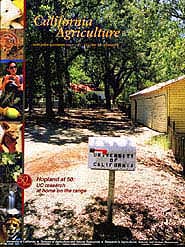All Issues

Hopland at 50: UC Research at home on the range
Cover:
UC's presence extends beyond campuses and classrooms, to rustic environments such as the UC Hopland Research and Extension Center in southern Mendocino County. As Hopland celebrates its 50th anniversary, California Agriculture features new and long-term research emanating from the center, once known as the Hopland Field Station. Beyond the HREC office mailbox is "Duncan House," the Pratt Ranch homestead at the time UC purchased the land from Roy L. Pratt in July 1951. The house was expanded and served as the Hopland Field Station office until 1961; it was also the residence of Superintendent Alfred H. Murphy ans his family from 1951 until his residence in 1986.
Main Photo by Phil Schermeister; inset photos by various photographers (see inside).
November-December 2001
Volume 55, Number 6
Volume 55, Number 6





